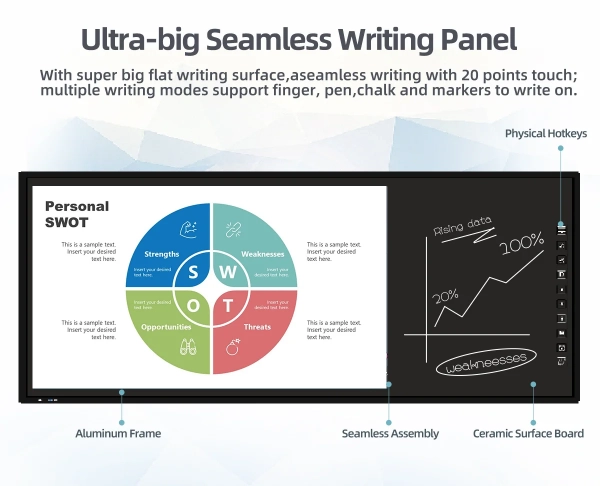Advantages of Touch Screen Blackboard in K12 Education
4 min readAll-In-One interactive displays enhance interactivity, engagement and learning outcomes, combining smart technology with traditional teaching methods to become a way for educators to teach and for students to interact with learning materials. As a high performance one stop interactive flat panel manufacturer, we will share the advantages of touch screen blackboard in K12 education.
Advantages of High Performance Touch Screen Blackboard in K12 Education
1. Enhanced Interactivity and Engagement
Traditional blackboards limit interaction to writing and erasing content, whereas touch screen blackboards allow dynamic engagement. Features such as multi-touch capabilities enable multiple students to interact with the screen simultaneously, fostering collaborative learning. Teachers can incorporate:
- Real-time annotations on digital textbooks and lesson materials.
- Drag-and-drop activities that help students engage with content interactively.
- Virtual simulations, such as science experiments, to enhance conceptual understanding.
- Gamified learning experiences that make lessons more enjoyable and effective.
With these capabilities, students remain more engaged, and learning becomes an interactive two-way process rather than a passive one.
2. Improved Content Delivery and Versatility
A touch screen blackboard serves as a multi-functional teaching tool. Unlike traditional blackboards, where content must be erased to make space for new material, digital blackboards allow:
- Seamless integration with multimedia content, such as videos, 3D models, and images.
- Access to online educational resources, enabling teachers to supplement lessons with real-world examples.
- Pre-loading of lesson plans, saving time and allowing smoother transitions between topics.
- Split-screen functionality, letting educators display multiple resources simultaneously, such as a question on one side and an explanatory video on the other.
This level of versatility enhances the depth and breadth of lesson delivery, providing students with a richer learning experience.

3. Increased Accessibility and Inclusion
Touch screen blackboards support universal design for learning (UDL) principles, making education more inclusive. Some key accessibility features include:
- Text-to-speech functionality, aiding students with reading difficulties.
- Adjustable font sizes and color contrast, benefiting visually impaired students.
- Real-time translation and captioning, assisting non-native speakers and hearing-impaired students.
- Adaptive learning apps, catering to students with diverse learning styles.
By accommodating different abilities and learning preferences, touch screen blackboards promote equitable education opportunities for all students.
4. Eco-Friendliness and Cost Efficiency
While the initial investment in touch screen blackboards may seem high, they offer significant long-term savings and environmental benefits:
- Eliminates the need for chalk and markers, reducing recurring costs and classroom dust exposure.
- Digitized assignments and notes reduce paper usage, supporting sustainability initiatives.
- Lower maintenance costs compared to traditional blackboards and whiteboards.
- Energy-efficient models, many of which consume less power than projectors and other traditional display systems.
By reducing material waste and promoting a paperless learning environment, schools can contribute to environmental sustainability while cutting operational costs.
5. Integration with Learning Management Systems (LMS)
Touch screen blackboards seamlessly integrate with LMS platforms, allowing teachers to:
- Upload and retrieve lesson plans from cloud-based storage.
- Track student progress through digital assessments and interactive quizzes.
- Enable remote learning, where students can access recorded lectures and study materials from home.
- Facilitate real-time collaboration, where students can share screens and contribute to discussions remotely.
Such integrations streamline administrative tasks and foster blended learning models, ensuring students receive consistent and high-quality instruction regardless of location.
6. Enhanced Classroom Management and Organization
With a touch screen blackboard, teachers can manage their classrooms more efficiently:
- Pre-set lesson structures, reducing wasted time between topic transitions.
- Automated attendance tracking using facial recognition or student logins.
- Behavior management tools, including engagement tracking and real-time feedback.
- Instant screen mirroring for quick display of student work and peer reviews.
These functionalities help educators maintain a structured and engaging classroom environment, leading to improved student performance.
7. Adaptability for STEM and STEAM Education
STEM (Science, Technology, Engineering, and Mathematics) and STEAM (which adds the Arts) education rely heavily on visual representation and hands-on learning. Touch screen blackboards excel in this area by providing:
- 3D modeling tools for physics, biology, and engineering concepts.
- Virtual labs for conducting simulated experiments safely.
- Code learning applications, allowing students to write, debug, and execute programs in real time.
- Mathematical equation solvers with step-by-step problem-solving guides.
These advanced tools demystify complex concepts, making them easier to understand and more engaging for students.
8. Supports Hybrid and Remote Learning Models
In the wake of the global shift towards blended and remote learning, touch screen blackboards enable:
- Real-time video conferencing integration with platforms like Zoom and Microsoft Teams.
- Cloud-based lesson sharing, ensuring students have access to materials anytime, anywhere.
- Live annotations, allowing remote students to interact with lesson content just like in a physical classroom.
- Digital homework submission and assessment, streamlining feedback and grading processes.
Such capabilities make touch screen blackboards an indispensable tool in the modern digital classroom.
Conclusion
The adoption of touch screen blackboards in K-12 education presents a transformative shift in how teachers teach and students learn. By enhancing interactivity, increasing accessibility, reducing environmental impact, and integrating seamlessly with digital learning ecosystems, these smart boards pave the way for a more engaging, inclusive, and efficient education system. As technology continues to evolve, schools that invest in these digital tools will be better positioned to meet the demands of 21st-century education, empowering students with the skills and knowledge needed for future success.
www.orgscreen.com
Interactive Flat Panel OEM/ODM
